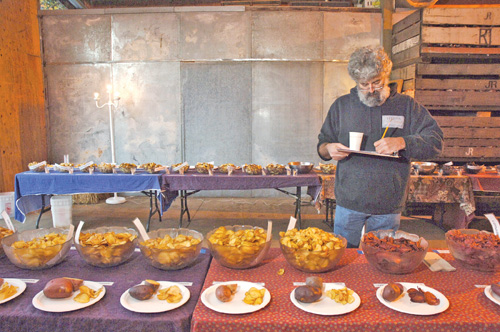
Features
Production
Research
Not your father’s potato
Oregon State University develops new spuds for organic m
March 17, 2008 By Fruit & Vegetable
The skin of the potato is a deep
garnet red, its flesh a brilliant ruby. When boiled and mashed it turns
a creamy fuchsia. As a chip it’s a delicate rose pink that would fit in
at tea parties and fundraisers.
 |
| Brian Yorgev, a researcher in the Department of Food Science at Oregon State University, participates in the university’s first organic potato tasting day at Gathering Together Farms in Philomath, Ore. More than 23 varieties of potatoes were presented and judged on taste, texture, colour and shape. Contributed photo |
Oregon State University develops new spuds for organic markets
The skin of the potato is a deep garnet red, its flesh a brilliant ruby. When boiled and mashed it turns a creamy fuchsia. As a chip it’s a delicate rose pink that would fit in at tea parties and fundraisers. This stylish spud is one of several new varieties under consideration for possible organic production in the northwest.
Researchers at Oregon State University are evaluating thousands of potential selections in both traditional and specialty-type market classes. Isabel Vales, the university’s foremost researcher on potato breeding and genetics, is focusing on molecular and conventional breeding for resistance to pests and disease. The aim is to identify selections that have the potential to be grown under organic systems without the use of synthetic pesticides.
Synthetic pesticides are often expensive, but because of current crop requirements, they play an important role in large-scale production. As varieties are developed that are better suited to their environment, the need for synthetics may decline, possibly resulting in improved net returns for growers.
Much of the vegetable breeding being done today focuses on value-added traits. These traits may include better taste, unusual shapes, different skin and flesh colours and increased levels of phytochemicals — chemicals in plants thought to have protective or disease preventive properties. These traits could add selling power in all markets, Vales says.
Added-value varieties that include disease, pest and various stress resistances may have more to offer growers than any other growing input, adds Brian Charlton, a cropping systems and potato variety researcher at the OSU College of Agricultural Sciences Klamath Basin Research and Extension Center.
The OSU potato team is gathering together crop and soil scientists, horticulturists, and food scientists to identify selection criteria for organically grown potatoes.
“We are interested in developing potatoes suitable for organics, and also on evaluating taste and chemical composition of the more promising lines,” says Vales.
The organic market continues to grow with each production season. U.S. organic food sales grew at a double-digit rate from $1 billion in 1990 to more than $14 billion in 2005 and are expected to exceed $16 billion by the end of 2006. This is the fastest growing segment of the food industry, offering many opportunities and areas of concern, says Vales. In order for growers to have an edge in organic markets, they will need varieties that can compete with traditional breeds.
Mainstream growers are constantly looking at ways to remain competitive and boost their net returns per acre, Charlton adds. As organic produce moves closer to conventionally grown foods in price, many growers see putting at least some of their land into organic and transitional production as a way to add value to their crops.
“I envision more and more growers adopting sustainable or true integrated pest management practices in an effort to curtail input costs,” says Charlton. “Unfortunately, products grown under these parameters are often lost in the marketplace. Consumers generally have a choice between conventional and organic with few options in the middle.”
Print this page